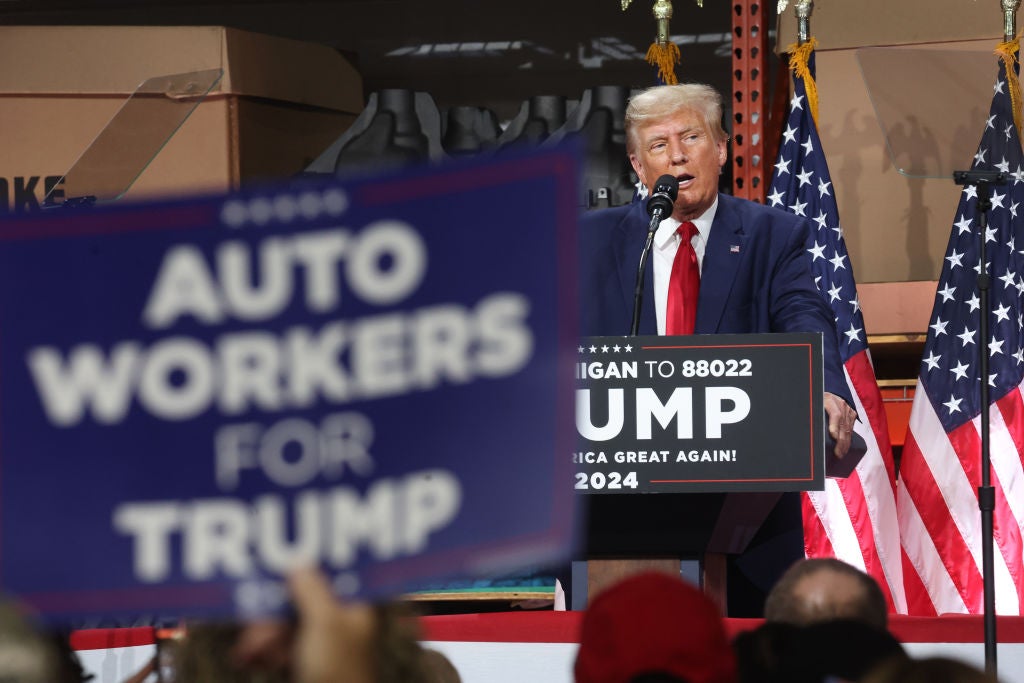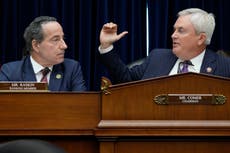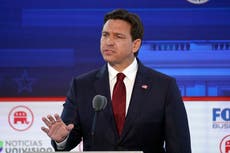Did Trump fake union turnout at his Michigan rally?
Ex-president’s claim to have organised an audience of ‘hundreds’ of union members remains unlikely
Your support helps us to tell the story
From reproductive rights to climate change to Big Tech, The Independent is on the ground when the story is developing. Whether it's investigating the financials of Elon Musk's pro-Trump PAC or producing our latest documentary, 'The A Word', which shines a light on the American women fighting for reproductive rights, we know how important it is to parse out the facts from the messaging.
At such a critical moment in US history, we need reporters on the ground. Your donation allows us to keep sending journalists to speak to both sides of the story.
The Independent is trusted by Americans across the entire political spectrum. And unlike many other quality news outlets, we choose not to lock Americans out of our reporting and analysis with paywalls. We believe quality journalism should be available to everyone, paid for by those who can afford it.
Your support makes all the difference.Donald Trump’s speech to a crowd in Clinton Township, Michigan, could not have contrasted with the day-earlier visit by his likely 2024 opponent to any greater degree.
While Joe Biden was on the picket line and making a name for himself as the most pro-labour president since at least FDR, if not in history, Donald Trump was preparing for a much different visit to the Rust Belt — one that was in many ways very typical of a politician like him.
For days leading up to Mr Trump’s Wednesday visit, a cascade of news stories highlighted his plans to “speak to union autoworkers”. The Detroit Free Press, New York Times and other reputable media outlets ran with the claim that Mr Trump would speak to an audience of 500 “former and current” union autoworkers, based on details released by the Trump campaign on day four of the United Auto Workers (UAW) strike.
But like everything with Donald Trump and his facts-optional brand of politics, the truth of the matter was hopelessly obscured both by his own operatives and credulous reporters who repeated a canned press release ad nauseam.
Mr Trump spoke on Wednesday evening and delivered potentially one of the strangest speeches a GOP politician has given in recent memory. The Republican ex-president, a member of a party that has famously battled unions for decades and whose members speak of teachers’ unions with the same level of disrespect they reserve for organised crime, pleaded for union votes and urged his audience to push UAW president Shawn Fain to endorse him.
The speech was a battle between Mr Trump’s own political instinct to back a group of striking workers who have overwhelming support among the American public, and the actual policies and concessions that his party would typically turn up its nose at. The former president wasn’t able to get on board with all of the union’s demands, and found himself at odds with its stance on electric vehicles, but also shied away from the labour-bashing big business-obsessed rhetoric of his Republican peers.

But who actually heard that speech? In the days leading up to his visit, journalists including Jacobin’s Alex Press who dug into the matter quickly uncovered basic facts about the trip that seemed to contradict the campaign’s stated promise that the candidate would be addressing workers who were members of a union. Drake Enterprises, the venue for the speech, is a non-union employer.
More Perfect Union, a left-leaning outlet specialising in labour journalism, also attempted to track down union autoworkers at the event and posted the results on Twitter. Notably, their reporters were not seen inside the event in the footage.
And that’s far from all of it. UAW sources who spoke to The Independent ahead of the event said that Mr Trump’s team had not reached out to them on any level. So where was this audience coming from? And how would the Trump campaign be confirming that they were current or former union members, if not by contacting UAW or another union? There was even reporting, once again from Jacobin, indicating that the National Right to Work Foundation, a major anti-union think tank, was behind hosting the rally. NRTW officials did not respond to an emailed request for comment from The Independent.
In the hours ahead of the Trump speech itself, it looked increasingly unlikely that the campaign was going to keep its word and have the president come face-to-face with any striking union workers at all, let alone 500. Requests for comment from Trump campaign officials went unanswered, and the GOP candidate’s team wouldn’t even say whether the choice of a non-union shop as the venue was significant.
Finally, we reach the night of the speech itself. The former president had timed it to coincide with the second Republican debate in California, meaning that the focus of the Republican primary electorate would be split for the night and also guaranteeing that many DC reporters were fixed on the debate instead. Those who were present for his remarks, including The New York Times, attempted to crack the days-old mystery wide open.
The verdict? First of all, it seems the “500” number was a headcount for the entire audience of the speech — including non-unionised participants. And to be sure, there was some deception afoot. Two Trump supporters holding “Union Members for Trump” signs told the Times that they were not actually union members, sort of like how white Trump supporters keep being photographed in “Blacks for Trump” shirts and signs at his rallies.
Emailed requests for further details from the Trump campaign elicited a response from Steven Cheung, a former White House comms official now serving as Mr Trump’s post-presidential campaign spokesman.
“We never said every person would be a member of the union,” said Mr Cheung, who ignored a question about people in the audience falsely identifying as such. When pressed as to how many union workers attended, he added, “Hundreds”. The campaign offered no means of verifying or proving that number’s authenticity.
In the end, there were likely at least some unionised workers at the event. At least one person who spoke to the Times identified themselves as a strike-supporting union worker and was clad in a UAW shirt at the event. But it looks highly unlikely, just given the ease that reporters had identifying the hangers-on, that the event was hardly centred around or even included UAW strikers to a significant degree.
If Donald Trump is to make a third play for the Rust Belt in next year’s general election, his lacklustre effort to woo the UAW is most certainly going to factor into the results. What remains to be seen is whether he can convincingly cast himself as a pro-labour Republican when juxtaposed next to a Democratic president who has already shocked the establishment in his own party by taking a bold stance behind the strikes.







Join our commenting forum
Join thought-provoking conversations, follow other Independent readers and see their replies
Comments